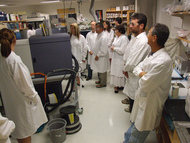- Home
- About Us
- TSPT Academy
- Online Courses
-
Resources
- Newsletter
- Business Minded Sports Physio Podcast
- Day in the Life of a Sports PT
- Residency Corner
-
Special Tests
>
-
Cervical Spine
>
- Alar Ligament Test
- Bakody's Sign
- Cervical Distraction Test
- Cervical Rotation Lateral Flexion Test
- Craniocervical Flexion Test (CCFT)
- Deep Neck Flexor Endurance Test
- Posterior-Anterior Segmental Mobility
- Segmental Mobility
- Sharp-Purser Test
- Spurling's Maneuver
- Transverse Ligament Test
- ULNT - Median
- ULNT - Radial
- ULNT - Ulnar
- Vertebral Artery Test
- Thoracic Spine >
-
Lumbar Spine/Sacroiliac Joint
>
- Active Sit-Up Test
- Alternate Gillet Test
- Crossed Straight Leg Raise Test
- Extensor Endurance Test
- FABER Test
- Fortin's Sign
- Gaenslen Test
- Gillet Test
- Gower's Sign
- Lumbar Quadrant Test
- POSH Test
- Posteroanterior Mobility
- Prone Knee Bend Test
- Prone Instability Test
- Resisted Abduction Test
- Sacral Clearing Test
- Seated Forward Flexion Test
- SIJ Compression/Distraction Test
- Slump Test
- Sphinx Test
- Spine Rotators & Multifidus Test
- Squish Test
- Standing Forward Flexion Test
- Straight Leg Raise Test
- Supine to Long Sit Test
-
Shoulder
>
- Active Compression Test
- Anterior Apprehension
- Biceps Load Test II
- Drop Arm Sign
- External Rotation Lag Sign
- Hawkins-Kennedy Impingement Sign
- Horizontal Adduction Test
- Internal Rotation Lag Sign
- Jobe Test
- Ludington's Test
- Neer Test
- Painful Arc Sign
- Pronated Load Test
- Resisted Supination External Rotation Test
- Speed's Test
- Posterior Apprehension
- Sulcus Sign
- Thoracic Outlet Tests >
- Yergason's Test
- Elbow >
- Wrist/Hand >
- Hip >
- Knee >
- Foot/Ankle >
-
Cervical Spine
>
- I want Financial Freedom
- I want Professional Growth
- I want Clinical Mastery
 Learning, re-learning, challenged, fun. Those are the four words I would use to describe my experience in USC's sports residency program thus far. The experience has been absolutely incredible. As football season comes to a close, what I have noticed the most is the experience I have gotten with acute injuries on the field. I'm comfortable being the first one to run on the field, assess the injuries, and make the appropriate decision. The thing about very acute injuries is often they do not present as they would in a clinical setting. This is why I think going through a sports residency is so crucial to developing skills as a sports physical therapist. Furthermore, for a player who complains of shoulder pain, its very hard to assess a dislocated shoulder with all the pads on. Learning new tricks to assess injuries with pads on was a really useful tool for me. More importantly, just being able to see these injuries have been tremendous to my growth as a sports PT. Concussions, ACL's, MCL's, hip pointers, broken tibia, ankle sprains, grade 1-3 AC joint sprains, dislocated shoulders, cramps, bone bruises, and many more. The USC literature reviews each week that both the sports and orthopedic residents come together to discuss have been very eye-opening. We come together with the orthopedic residency director to discuss the backgrounds of all the authors of the articles and the articles relevance/downfalls. This has really opened my eyes to how effective the practice guidelines are, the CPR's relevance, and much more. Always is good to have a critical eye when analyzing evidence. Finally, USC brought in Laurie Hartman and Bill O'Grady this past week for all the USC residents/faculty to discuss manipulations and have a lab. It was unbelievable to feel and see how these two pioneers performed manipulations! Lastly, the mentoring aspect of the program is what I have valued the most. In addition to getting the 4 hours of patient mentoring each week, I have been able to have additional mentoring on manual skills/special tests/interventions every Tuesday with two mentors. Each week we pick a body part and go through each test and different manual skills. They say practice makes perfect and I think this has been a really key component to my skills developing. Also, I have had unscheduled mentoring on multiple occasions. The best example of this was when I brought one of my college pitchers out to throw and one of mentors brought her MLB guys out to throw as well. My mentor spent time and helped me look at different throws to determine what to look for and what I should think about when fixing mechanics. It's times like those that I am really happy I chose USC's sports residency. I'm adding new techniques and reflecting on my clinical reasoning each week and have seen a marked improvement. -Brian
4 Comments
 A big part of a residency program is the 1-on-1 mentoring that occurs each week. At the Harris Health System Orthopedic Residency, I am fortunate enough to get at least 5 hours of mentoring each week. In order to maximize the effectiveness of each session, the program faculty have drafted a form that residents are expected to complete prior to each mentor session. This forms gives both the resident and faculty mentor a clear picture of the patient they are about to treat. Key features include: Red Flags, Pertinent Positives and Negatives regarding patient status, literature to reinforce each intervention selected, and Asterisks signs. The form is useful for anyone, especially those difficult patients where prioritizing interventions can be difficult. I recommend this form to any student or clinician who is trying to better organize their treatment session. Click the link below to access the form: /uploads/1/3/2/6/13261333/ortho_mentorship_form_for_tsptwebsite.pdf -Jim |
Copyright © The Student Physical Therapist LLC 2023

 RSS Feed
RSS Feed